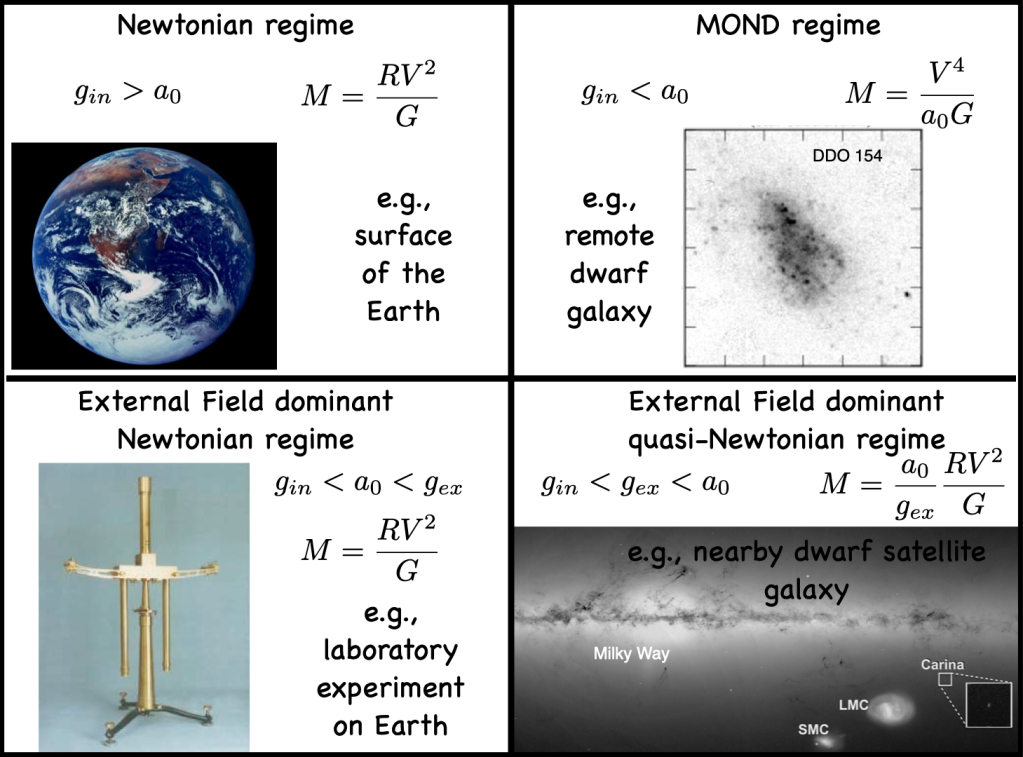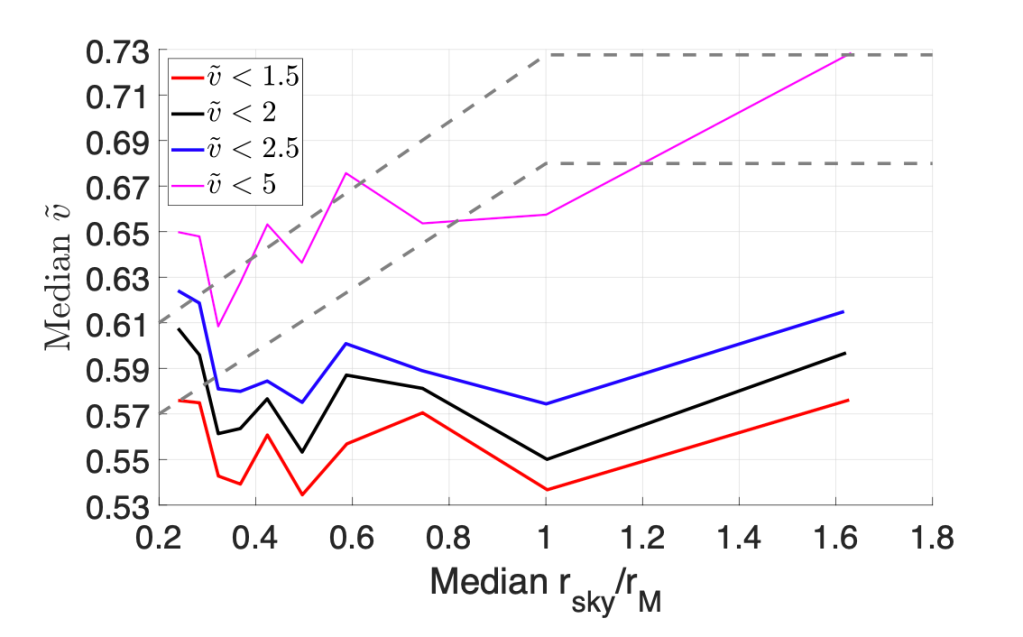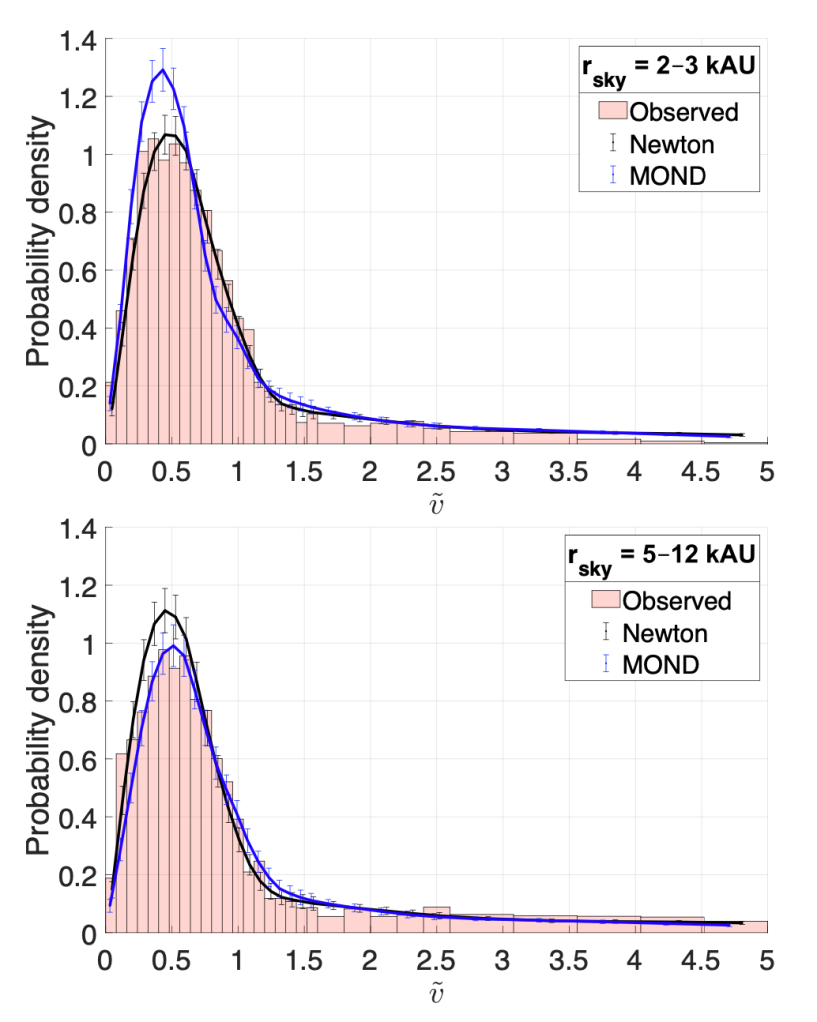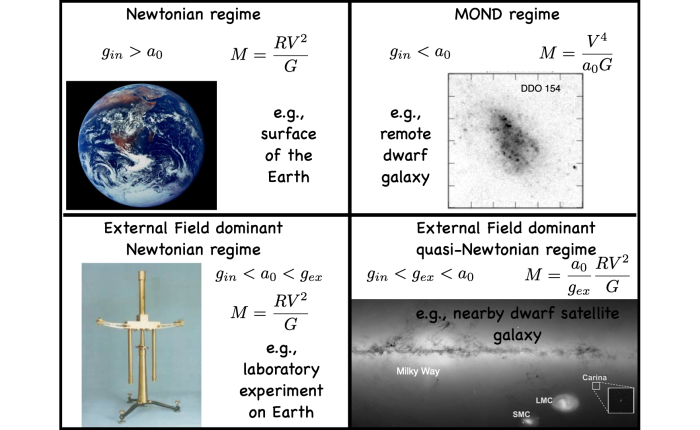I have tried very hard to remain objective and even handed, but I find that I weary of the wide binary debate. I don’t know what the right answer will turn out to be. But I do have opinions.
For starters, it is a big Galaxy. There is just too much to know. When I wrote about the Milky Way earlier this year, the idea was to set up an expectation value for wide binaries in the solar neighborhood. That devolved into at least eight other posts on the Milky Way itself, because our Galaxy is too damn interesting, and has its own controversies. So it occurs to me that I never really got on with the regularly scheduled program.
In my assessment, the radial acceleration at the solar circle is 2.2 x 10-10 m/s/s, which in terms of the MOND acceleration scale is 1.8 a0. We live on the Newtonian side of the transition to the MOND regime. The ideal place to test MOND with wide binaries would be the deep MOND regime, well below a0. That is in a part of the Galaxy that is far, far away, and not currently accessible to us. What is accessible are wide binaries in the solar neighborhood (within 250 pc, about 1% of the Galaxy’s radius) as mapped by Gaia. Locally, the MOND effect is modest, but nonzero. We’re close enough to the transition for there to be a small, detectable effect.
Local binaries that are widely separated enough for their internal acceleration to drop below a0 find themselves in the regime dominated by the field of the rest of the Galaxy and subject to the so-called External Field Effect (EFE). This situation is illustrated in the lower right panel below.

Intriguingly, orbits in the EFE regime remain Keplerian. The rotation curves of nearby binaries, if you could map them, are not expected to be flat in MOND. They should, however, experience enhanced speeds, with a boost to the effective value of Newton’s constant: G → γG. The value of γ depends on the sum of internal and external acceleration as well as the shape of the interpolation function when near a0. That’s one reason to prefer to do this experiment in the deep MOND regime, where the shape of the interpolation function doesn’t matter. But that’s not where we live. For Galactic data and viable possibilities* for the interpolation function, a reasonable expectation value is γ = 1.4 ± 0.1. This is what the wide binary papers attempt to measure. So, what do they find?
Hernandez et al. find γ = 1.0±0.1 for 466 close binaries with 2D separations less than 0.01 pc (about 2000 AU) and γ = 1.5±0.2 for 108 wide binaries with 2D separations greater than 0.01 pc. A purely Newtonian result (γ = 1) is recovered in the high acceleration regime of relatively close binaries where this is expected to be the case. For wider binaries, one finds a boost value consistent with the prediction of MOND and differing from Newton with modest significance (2.6σ).
Chae reports+ γ = 1.49(+0.21/-0.19) for 2,463 “pure” binaries in the low acceleration regime, consistent with his earlier result γ = 1.43±0.06 for 26,615 wide binaries. The larger numbers make the formal error smaller, hence a formally more significant departure from Newton. Many of these binaries are impure in the sense of being triples with one member being itself a close binary as discussed previously, an effect that has to be modeled in large samples. The point of the smaller samples is to select true binaries so that this modeling is unnecessary. For his smaller pure binary sample, Chae finds a smooth transition from γ ≈ 1 at high acceleration (10-8 m/s/s ≈ 100a0) through γ ≈ 1.11 around 7a0 to γ ≈ 1.49 at local Galactic saturation (1.8 a0).
Banik et al. use a slightly different language. Translating, they find γ = 1 at high confidence (16σ)$ from 8,611 wide binaries with separations from 2,000 to 30,000 AU. Newtonian behavior persists at all scales and accelerations; they find no significant deviations from γ = 1 anywhere. Note that despite going out very far, to 30,000 AU, they do not reach especially low accelerations because the EFE of the Galaxy is effectively constant in the solar neighborhood. There is no getting away from the Galaxy’s 1.8 a0. They also do not reach particularly high, purely Newtonian accelerations: 2,000 AU is in the transition regime where MOND effects are perceptible.
Here is Fig. 11 from Banik et al., the key figure Dr. Banik was advocating in his comments to the previous post:

A flat line in this plot indicates no boost in velocity with diminishing acceleration, so one can clearly see the source of the claim that Newton works better than MOND. There is little indication that the velocity increases at wider separations. Effectively, γ ≈ 1 pretty much everywhere.
Both Chae and Hernandez have pointed out that the lack of a constraint on the high acceleration Newtonian regime is problematic. Orbits are Keplerian in the quasi-Newtonian regime, so the behavior looks Newtonian. Lacking an anchor in the high acceleration regime, it is conceivable that the analysis of Banik is detecting the predicted MOND quasi-Newtonian behavior and defining it to be purely Newtonian. It’s just a modest offset in qualitatively similar behavior. In this context, it is worth noting that Chae and Hernandez independently measure γ ≈ 1 at high acceleration as well as γ ≈ 1.5 at low acceleration: they [claim to] detect the difference between these regimes in a way Banik does not probe.
Now let’s look at the plot that gave me the heebie-jeebies with data on it, Banik et al.’s Fig. 12:

One can see the basis of the concern. At high acceleration, the prediction of Newton and MOND are identical. The top bin is the closest we get to that, yet there is a clear difference in the predictions. This bin is in the transition region; there is no bin at sufficiently high acceleration for the predictions to align and provide the self-calibration that both Chae and Hernandez independently exploit.
Looking at the data in the top panel, it clearly agrees better with the Newtonian prediction. I can believe that; what concerns me is the lack grounding at still higher acceleration where the black and blue lines should coincide. I do not have a sufficiently clear understanding of all the machinations (and their inevitable foibles) that go into the predicted lines to trust that this constitutes a definitive test.
Looking at the data in the bottom panel, it clearly agrees better with the prediction of MOND. The histogram of the data follows the blue line of MOND more closely than the Newtonian black line. This is so obvious that I wondered if the colors were wrong – maybe there had been some inadvertent switcheroo in the line color in the plotting code. Apparently not, as this point is addressed in the text of Banik et al.: [in the bottom panel,] “MOND performs somewhat better in a handful of pixels around the peak region…” Yes. Yes it does. That’s… a really weird way of putting it. They go on to say “…though given the uncertainties, the Newtonian model is not that far off.” One could just as well say that about MOND in the top panel. Just looking at this figure, one might conclude that they have detected MOND at large separations.
One of the things that gives me the heebie-jeebies about this figure is that there isn’t much difference in the location of the peaks of the distributions. Some, yes, but not much: Newton and MOND apparently predict very nearly the same typical velocity. Yet that is what Fig. 11 traces: the typical (median) normalized velocity. That only tells a tiny bit of the story that is in Fig. 12, and does not appear to be a particularly sensitive indicator of the effect we’re testing for.
Returning to the matter of statistics, the attentive reader might have noted that I have not said much about the number of binaries included in each analysis. These range from a few hundred to many thousands to tens of thousands. More is better, right?
In this case, I think not. There is always a tension between data quality and quantity. Quantity helps with the statistics, but only so long as there is a signal to be dug out. At some point, it becomes a matter of garbage in, garbage out. In this respect, I am inclined to agree with Ernest Rutherford:
If your experiment requires statistics, you ought to have done a better experiment.
Ernest Rutherford$
I suspect that we’re squeezing the stone of statistics too hard here. When we do this, we get the appearance of a signal when really we’re just grinding metal. I am reminded that any time we do a big experiment like this (dark matter searches are a great example), the first thing we learn about are all the false signals we didn’t anticipate. That happens no matter how well we construct the experiment, and I give Banik et al. credit for planning this out ahead of time. That doesn’t guarantee that everything comes out right on the first attempt. There is just so much junk that the universe can and does throw at us that it is easy to imagine that the samples with large numbers of binaries bring with them too much junk (e.g., false binaries). If the fraction of junk is high, then it will look like junk at all scales – there will be no trend with increasing separation even if there is a signal buried in junk.
Consequently, I am at present inclined to trust more the super-clean sample of Hernandez – the high quality binaries where there is a chance that we’re actually measuring what we want to measure. There are only a few hundred such binaries, so the statistical confidence is modest (2.6σ). I worry that in setting the highly restrictive standards necessary to select the best binaries that we might unintentionally omit objects that could change the answer. But at least there is some confidence that these are real binaries that stands above the accumulation of all the gratuitously enormous amount of junk the universe has to throw our way.
I hope the principal scientists can come to agreement about what the data show and not just wind up having the same argument over and over forever more. That’s what usually happens. I ask all parties to remember that it is important to retain the ability to change one’s mind. All of them have demonstrated the ability to do this previously, and somebody will need to do it again.
*In principle, one might also hope to distinguish between specific theories of MOND. Examples of modified gravity like AQUAL and QUMOND give slightly different predictions. To be able to do this seems… optimistic at this point.
In modified inertia theories, the interpolation function is a chimera that depends on each orbital trajectory, so its effective realization may differ between the nearly circular motions of rotation curves and eccentric wide binaries. If so, the interpolation function defined by external galaxies may not be relevant to the problem. Ultimately, we need a theory that automatically results in the MONDian phenomenology in galaxies. Whatever it is wide binaries are doing should help inform this theory development as well as test alternatives and hopefully exclude some of them.
+The work of Chae has gone through some revisions in response to a referee, but the basic findings are unchanged. Having read an earlier version, I appreciate the clarity provided by the additions: this is a case where the refereeing process was beneficial. (I was not the referee of this or any of these papers. Editors keep me busy enough as it is, thank you very much.)
$Outside of long-established observations like the value of Gauss’s constant, there is no such thing as 16σ confidence in astronomy. The tails of real probability distributions are never as tiny as a pure Gaussian. This is a remarkably naive assertion.



